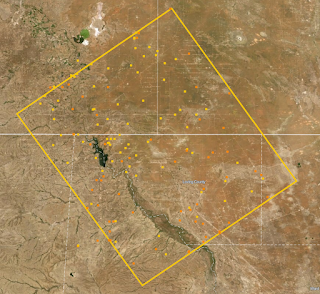Flaring from Oil & Gas Production
Flaring from Oil & Gas Production
Per the World
Bank, the world currently flares roughly 3.25 tcf of natural gas per year. Some of these flares are visible from
satellite pictures, as shown in Figure 1.
The World Bank has solicited support to end this flaring
by 2030, and a number of countries and companies have signed on to the
initiative. Progress has been made (see Figure 2),
however, there is still much work to be done.
Figure 2 - Long-term gas flaring trend (World Bank)
This goal will require multiple solutions to eliminate
routine gas flaring and unless these are commercially viable solutions, it is
difficult to imagine that this initiative will succeed. Three challenging examples are described
below.
Shale Oil Wells
Shale oil wells, seen in Figure 3
& Figure 4,
typically:
·
have a very short life (18 months to three
years)
·
low production rate per well (<1500 barrels
per day)
·
are spaced a few miles apart
·
are located in remote areas, and
their associated
gas rates (< 1 mmscfd) are generally so low that conventional solutions for
recovery are uneconomical .
Figure 3 - Sample Shale Oil Field
It is for this reason that the Texas
legislature, for example, exempts collection of or even flaring of gas
where the flare rate is less 50,000 scfd from an individual well.
Figure 4 – Fall 2021 Methane Emission in Western
Permian Basin
Stranded Gas
Further, trillions of cubic feet of Natural Gas are
stranded in remote harsh environments world-wide where conventional solutions
for recovery are currently not viable.
The Oil & Gas industry has made great strides in
eliminating routine flaring from large facilities by either collecting the gas
from multiple fields and liquifying it into liquified natural gas (“LNG”) or
re-injecting back into the reservoir.
But there are a number of challenges that have to be
over-come.
·
In certain parts of the world, where there is considerable
civil unrest, the pipe-line networks are routinely destroyed and the LNG plants
become inoperable.
·
In other parts, the on-shore gas plant, not
operated by the Oil company, may fail due to any number of reasons and be
incapable of receiving the gas.
·
For certain formations, it is not possible to
re-inject or continue to re-inject the gas.
·
Gas re-injection can require extremely
high-pressure compressors requiring significant power and space which the
existing facilities may not be able to accommodate.
Figure 5 - OSO complex operated by ExxonMobil in Nigeria (Business Wire)
In the example shown in Figure 5,
the Oil company had to build additional bridge-connected platforms to collect
portions (LPG) of the flared gas at significant cost. Even then, the gas had to be sent to
shore. While this is practical for
certain fields such as Oso, which is located near the Bonny Island LNG plant,
it is not viable for all. Thus, often in
modern field developments, the gas is re-injected at negative NPV for the
overall development from:
·
Capital and operating cost for the gas
compression, associated processing (gas dehydration), power, utilities and
chemicals
·
Capital cost for drilling the injection well(s)
·
Capital cost for the subsea, risers, umbilicals,
and flowlines
As well as lost potential revenue from the injected
gas.
Eventually (typically 7 years), the injected gas
breaks through the formation and the produced Oil to Gas ration is further
reduced (in favor of the gas) making the project less and less commercially
attractive.
Thus, at some point in the future, there will be a
great number of fields currently in use, where the re-injected gas will become
stranded.






